Lea Wait's Blog, page 75
December 9, 2022
READ ONLY IF YOU LIKE BIC/FOK AND FOOD
by Jule Selbo
Every writer knows this: if you have dedicated yourself to getting out a book once a year (or nine months or six months or at whatever pace works for you), you commit to BIC/FOK time. Butt in Chair, Fingers on Keys.
For me, this is a body/sense memory element and super-ingrained in my everyday life. Friends and family know that my ‘grouch’, and ‘unsatisfied with all things living’ mood emerges if I don’t start my early morning hours in BIC/FOK.

And I try to stay in the same routine even when I have to/get to travel.
A lot European hotels make keeping to a BIC/FOK schedule easy because a free breakfast often comes with the room and is provided on the premises. Even before the buffet is revealed, some kind soul at reception will point you to a coffee urn and there will be a table where you can open the computer and take care of BIC/FOK.

I was invited to visit Stockholm, Sweden last month to give a speech at a film conference. The Film Institute put me up in a hotel room that had a bed, but no chair, no desk, no place to unpack and no place to put my small travel suitcase. Basically, the routine was this: flip the suitcase onto the bed, unzip, grab the pjs and toothbrush, put the suitcase back by the entry door (and hope there’s not a fire and that the case will block you from getting through the door), dress for bed in the tiny bathroom and then leap onto the mattress because the sides of the bed meet the walls. Very very small.
 However, the lobby was great, it was lined with bookshelves, a jazz quartet played every night. But it was the morning I was interested in and it didn’t disappoint. The various nooks set up for morning breakfasters were comfortable; the tables didn’t wobble, and mellow music was on low volume. Coffee was plentiful.
However, the lobby was great, it was lined with bookshelves, a jazz quartet played every night. But it was the morning I was interested in and it didn’t disappoint. The various nooks set up for morning breakfasters were comfortable; the tables didn’t wobble, and mellow music was on low volume. Coffee was plentiful.

By the time other hotel guests wandered down – I was well into my BIC/FOK headspace (working on 8 DAYS, the next in the Dee Rommel Mystery series) and the happy breakfast chatter was not distracting as they (and me) enjoyed the Nordic buffet that included smoked salmon, smoked moose, toast, eggs, yogurt and cereals, bear jerky, breads and muesli.
After the three-day conference was over, my husband joined me, and we moved to a hotel where two people could exist in one (still small) room. There was a tiny closet for our winter coats, and it also had a few shelves, so we could unpack a bit. But still – no desk or chair and sitting in bed and typing has never worked well for me in BIC/FOK time. I stayed to my early morning routine while Mark slept his jet-lagged sleep. (But of course, his alarm was set to get up before ten, he was not going to miss the breakfast buffet.) This hotel’s spread topped the first one – it was nearly a Babette’s Feast. Everything was displayed in silver bowls or on white china. A tureen of beautiful, hardboiled eggs with a de rigueur fish paste (in tiny tubes) caught my attention.

The tubes held an anchovy-roe tasty concoction that was to be squeezed out like toothpaste onto the peeled egg – an excellent salty, fishy addition. There were croissants, coriander buns (fabulous Swedish specialty – see pix I put in below), rye breads and salty/seedy crackers and all sorts of nutty, grainy granolas, heaps of whipped cream cheese and butter, prosciutto, sliced beef, bacon and sausages. And all the fresh fruit anyone could want.
 I’d drunk a thermos of coffee, polished up some pages and started a new chapter by the time my husband showed up to partake in the delicacies. Then it was off to the amazing VASA Museum to look at a fantastically huge warship built in 1628. The Vasa is a sailing vessel designed/commissioned by King Gustav II Aldof – it spent 400 years on the bottom of the Baltic Sea, within spitting distance of Stockholm. The King had ordered the shipbuilders to erect “the tallest warship ever”, ignoring their worries that the width and height were not properly proportioned for sailing. (It was 172 feet tall – a bit taller than France’s Arc de Triomphe (160 feet) and a bit shorter than the Eiffel Tower (185 feet tall), 226 feet long and – wait for it – yes – only 38 feet wide). He also insisted more and more artillery be added, ignoring observations that the ship’s weight was not properly calibrated for optimal movement in the water.
I’d drunk a thermos of coffee, polished up some pages and started a new chapter by the time my husband showed up to partake in the delicacies. Then it was off to the amazing VASA Museum to look at a fantastically huge warship built in 1628. The Vasa is a sailing vessel designed/commissioned by King Gustav II Aldof – it spent 400 years on the bottom of the Baltic Sea, within spitting distance of Stockholm. The King had ordered the shipbuilders to erect “the tallest warship ever”, ignoring their worries that the width and height were not properly proportioned for sailing. (It was 172 feet tall – a bit taller than France’s Arc de Triomphe (160 feet) and a bit shorter than the Eiffel Tower (185 feet tall), 226 feet long and – wait for it – yes – only 38 feet wide). He also insisted more and more artillery be added, ignoring observations that the ship’s weight was not properly calibrated for optimal movement in the water.

The King was not in attendance on August 10, 1628, when Vasa, with its crew of 450 men and women, was put to sea – it traveled only 1400 years before it tipped to its side, took in water, and sunk. Thirty people (or more, records were not great then) perished (some of their bodies are preserved under glass in the museum). The King kept mum, except to blame the shipbuilders and captain.

The Vasa was finally raised (a terrific feat) from the sea floor in 1961, urged back into port (only 1400 yards) and a museum was built around it. The workmanship, the sculptural details, the preservation (due to brackish waters in the port) are stunning.

I’ve included photos of its original painted essence and the beauty of the vessel, unpainted, as it’s seen in the museum today.

Imagine following that Vasa tour – four hours of awe – with a visit to the ABBA Museum. Yes, the four members of ABBA were all Swedes. And despite the cheesiness of the museum (it would be great for a teen sleepover party, karaoke opportunities galore), I ended up impressed by the musical chops of the group (they ended up doing opera, composing Broadway shows and more).
I usually get in 2-3 hour stint of BIC/FOK right before dinner. But I only tried to accomplish that out on two of our five days as tourists in Stockholm – decided that getting to know this place would have its own reward – hopefully – one day.
We made one more hotel move in Stockholm. This one was situated right on the water, closer to Sodermalm (there is an umlat in there over the ‘o’), close to the Nobel Museum and the old Royal Palace. The hotel was built in 1911 for visiting diplomats – so it’s got some fraying age on it – but the rooms are large. Ours had a wonderful desk overlooking the harbor and a couch and visiting chairs far enough away from the bed so that you almost felt you were in a separate room. It was 5th floor, with a tiny carriage elevator (think of the one Cary Grant and Audrey Hepburn shared in the movie Charade), so walking up the curving staircase past stained glass windows felt faster and more convenient than the lift…

I could’ve set up my computer on this desk in my large, diplomat-worthy room in the early morning. But I figured the breakfast buffet was bound to be spectacular and it was.
My morning table overlooked the port, candles at each place were glowing (the sun didn’t come up until almost 8 am), the servers were in white tuxedo jackets, heavy silverware was at the ready and crystal glasses were used for orange juice. Mountains of pastries, oatmeal and omelets to order, hollandaise served in gravy boats, brie and blue, cream and goat cheeses, crackers covered with parmesan, sliced hams, beef, salamis, dried and fresh fruit…

I nibbled a bit, but I almost hate to admit I ended up ordering oatmeal the three mornings we were here – it appealed my first diplomat day, and it was so perfect – I decided to stick to it. And I, actually, got more BIC/FOK done, staving off the distraction of hopping up every fifteen minutes or so to try some new Swedish farm-to-table taste.
We’ve been spending the last two and a half decades in NYC for Thanksgiving, to see off-Broadway theater that we love and to meet up with our daughter and extended family for a potluck Thanksgiving fest.
I love NY. But – of course – there’s no more morning breakfast buffet coddling. The lobby of our hotel in Chelsea was full of odd bamboo swings stuffed with feathered/fluffy pillows – no place to sit and work on the computer. I always choose to stay in Chelsea (using Marriott Reward points) because of the 24-hour Malibu Diner on 23rd and 7th. Sure, while walking there, I dodge the garbage bags that always line NYC streets (I didn’t know if the squeaky/sounds were from foraging rats or birds waking up (but how many birds are left in the city?) but I look forward to my time at Malibu diner.

The kitchen and serving staff are always as happy as if they were on the California beach, there’s actually a warmth here, a lack of NY coolness. I get there pre-6am for BIC/FOK and many of the morning regulars are already there or just coming off work – from the topless bars, fire stations, late-night-coders, early risers from the Home for the Blind down the street (it’s the only diner in NYC with a Braille menu).

One day, this trip, I even got to breakfast with some straggling wedding parties coming off all-night binges. The wi-fi works, the coffee flows and a NY bagel and some BIC/FOK is a thing of beauty.
I had spent some time (pre-trip) worrying that I wouldn’t find time move my story forward on this trip. But I managed it. And it was fine.
December 5, 2022
Candy Cane for the Soul
Please welcome Sylvie Kurtz as our guest blogger today at Maine Crime Writers. Sylvie lives in neighboring New Hampshire and writes wonderful novels loaded with adventure and romance. This week, just in time for Christmas giving, she has a new book coming out.
Candy Cane for the Soul
 Since moving back to the northeast, I’ve associated Maine with taking a break. When the kids were younger, we took them camping at Hermit Island or visited my aunt’s “shack” (which is anything but) on Arnold Pond. Then years later, we found a rental cottage in Phippsburg near Seawall Beach.
Since moving back to the northeast, I’ve associated Maine with taking a break. When the kids were younger, we took them camping at Hermit Island or visited my aunt’s “shack” (which is anything but) on Arnold Pond. Then years later, we found a rental cottage in Phippsburg near Seawall Beach.
That week in Maine every summer feeds my soul. It’s a chance to unplug, slow down and truly be with people. It’s also an opportunity to spend hours of guilt-free reading.
It’s on Seawall Beach, while walking ankle-deep in the water in the middle of the pandemic, that I figured out that I needed a break from writing suspense. The energy was too intense for my overwrought nervous system. I thought back to all the books I’d written and how I’d felt writing each of them. There’s something about each story that drew me to write it, but the one that I most enjoyed writing was A Little Christmas Magic. I wrote it to get myself out of a funk when I was away from family at the holidays and felt alone. And it worked; it gave me a new appreciation for what I did have and allowed me to let go of what I was missing.

Wanting to avoid the constant buzz of negativity and fear during the pandemic, I turned to watching a lot of Hallmark and reading more romantic comedies. They reminded me how much fun writing could be. So, I came up with a village in the middle of nowhere New Hampshire where life revolves around family, food and festivals—three of my favorite things.
 I developed a touch of agoraphobia at the height of the pandemic and threw that into Christmas by Candlelight, having Emma make fun of herself along the way. And because after a decade away from writing due to Lyme, I felt I couldn’t write anything well, I gave Meredith in Christmas in Brighton a case of perfectionism. Having characters work through their issues, helped me work through mine in a fun way. Add an explosion of Christmas merriment, and I found my way back to joy.
I developed a touch of agoraphobia at the height of the pandemic and threw that into Christmas by Candlelight, having Emma make fun of herself along the way. And because after a decade away from writing due to Lyme, I felt I couldn’t write anything well, I gave Meredith in Christmas in Brighton a case of perfectionism. Having characters work through their issues, helped me work through mine in a fun way. Add an explosion of Christmas merriment, and I found my way back to joy.
That’s what I hope these new stories give the reader—a break from the world’s seriousness and uncertainty; a way to hit the pause button and recharge their batteries, especially at this time of the year when everything seems stuck on fast forward.
So, this holiday season, curl up in your favorite chair, have your favorite hot drink nearby, and give yourself the gift of a chapter from your favorite author. You’ll go back to the seasonal madness feeling just a bit more grounded and peaceful.
 Happy Holidays!
Happy Holidays!
Christmas by Candlelight, Love in Brighton Village Book 1 – She’s duty bound to a dream–one that isn’t hers.
Christmas in Brighton, Love in Brighton Village Book 2 – Sometimes you have to get lost to find where you belong. Out today (Dec. 6th)–on sale for $0.99 for two days only.
Sylvie writes stories that celebrate family, friends and food. She believes organic dark chocolate is an essential nutrient, likes to knit with soft wool, and justifies watching movies that require a box of tissues by knitting baby blankets. She has written 23 novels. Visit www.sylviekurtz.com for more information.
December 4, 2022
Best Reads of 2022
As the year rolls toward its close—and with holiday shopping season in high gear—there are many Best Books of 2022 lists being written by book reviewers across the nation.

One annual list I find to be particularly well done is by my friend Kristopher Zgorski, whose review site is called BOLO Books. Kristopher’s picks this year include several books I’ve already read—The Murder Rule by the superb Irish writer Dervla McTiernan, Like A Sister, a page-turning domestic suspense novel by award-winning author Kellye Garrett, and The Secrets We Share, a thriller by Edwin Hill, which cost me a couple nights of sleep when I was immersed in its pages.
Four others on the BOLO list are on my To Be Read list—Val McDermid’s 1989,  the second in a new series featuring young journalist Allie Burns, Any Where You Run by Wanda Morris, whose 2021 debut All Her Little Secrets absolutely knocked me off my feet, Alex Segura’s Secret Identity, a noir plot set in the comic book world featuring a queer Cuban American protagonist, and A World of Curiosities by Louise Penny, whose Quebec-set books always make my must-read list. (Just so you know, in in retirement, I plan to move to Three Pines.)
the second in a new series featuring young journalist Allie Burns, Any Where You Run by Wanda Morris, whose 2021 debut All Her Little Secrets absolutely knocked me off my feet, Alex Segura’s Secret Identity, a noir plot set in the comic book world featuring a queer Cuban American protagonist, and A World of Curiosities by Louise Penny, whose Quebec-set books always make my must-read list. (Just so you know, in in retirement, I plan to move to Three Pines.)
The BOLO list includes links to Kristopher’s review of each book he chose as a best read of the year, which makes it a particularly useful shopping tool. Here’s the magic link: https://bolobooks.com/2022/12/top-reads-of-2022-according-to-bolo-books/
If I were compiling my best of 2022 list I’d add four books by MCW alums, and not just because they are MCW alums, but because they are terrific reads: Child Zero, a stunning, chilling, propulsive medical thriller (superior to Michael Crichton’s, IMHO) by Chris Holm, Hatchet Island by Paul Doiron, about murder and other diabolical happenings at an island bird sanctuary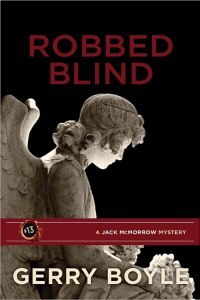 , Muddled Through the tenth book in Barbara Ross’ Maine Clambake cozy series, which gets stronger with each book, and Robbed Blind by Gerry Boyle, the fourteenth book in another truly engaging series featuring Maine reporter Jack McMorrow.
, Muddled Through the tenth book in Barbara Ross’ Maine Clambake cozy series, which gets stronger with each book, and Robbed Blind by Gerry Boyle, the fourteenth book in another truly engaging series featuring Maine reporter Jack McMorrow.
A number of my current colleagues here at MCW published new books this year, and I recommend each of them to you as you browse the bookstores (local if you can, okay?) for gifts for the crime fiction lovers in your life.
Richard Cass’s The Last Altruist is his first book set in Maine, a high-energy and emotionally touching tale of a former soldier still scarred from war-related trauma and not yet free of those who inflicted it. Kate Flora’s Death Sends a Message features old friend Thea Kozak. If you’ve not met Thea yet, you must. The whole series is terrific.
You won’t want to put down Vaughn Hardacker’s My Brother’s Keeper, until you reach the last page, so read it on a day when you’ve got time to dive in. Then there’s Matt Cost, a/k/a Mr. Prolific, who has two 2022 crime novels for your reading pleasure, Mainely Angst and Cosmic Trap (coming out later this month). And if you want a break from crime and enjoy historical novels, check out Matt’s At Every Hazard, Joshua Chamberlain and the Civil War.
Sanford (Sandy) Emerson is not an official member of the MCW blog, but he’s been an honorary one for some time, and not only because he’s married to our stalwart Kathy Lynn Emerson. 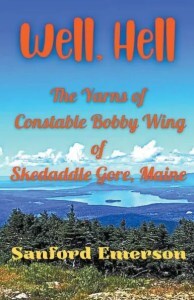 This year Sandy published The Yarns of Constable Bobby Wing of Skedaddle Gore, Maine and if you appreciate well-written, sharp (there’s no R in that word) Maine humor, you must read this book.
This year Sandy published The Yarns of Constable Bobby Wing of Skedaddle Gore, Maine and if you appreciate well-written, sharp (there’s no R in that word) Maine humor, you must read this book.
Four other books I read this year jump to mind as I think about what delighted me, thrilled me or inspired me in the past 12 months. Oh Danny Girl by my Cape Cod friend C. Michele Dorsey was one of them, a book of her heart that stole mine. Robyn Gigl’s Survivor’s Guilt, featuring transgender criminal defense lawyer Erin McCabe, is absolutely stunning. Kelly J. Ford’s Real Bad Things is a must-read for those who, like me, love a good dark, Southern gothic read, and William Kent Krueger’s Fox Creek, his latest Cork O’Connor book, was an immersive, satisfying visit with old friends in this long-running series.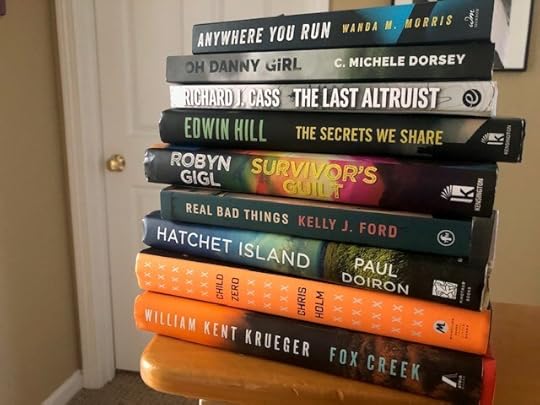
For my part, I did not publish a new book this year, fingers crossed that will change soon. But my short story Means, Motive, and Opportunity, published last fall in Bloodroot: Best New England Crime Stories 2021, made the “Other Distinguished Stories” list in Best American Mystery and Suspense 2022, an honor for which I am grateful.
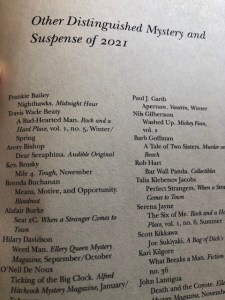
Happy holidays, friends! When you hit the local shops this holiday season, please remember the frequent advice of my good pal Dick Cass: books make wonderful gifts.
Brenda Buchanan brings years of experience as a journalist and a lawyer to her crime fiction. She has published three books featuring Joe Gale, a newspaper reporter who covers the crime and courts beat. She is now hard at work on new projects. FMI, go to http://brendabuchananwrites.com
December 2, 2022
Weekend Update: December 3-4, 2022
 Next week at Maine Crime Writers there will be posts by Brenda Buchanan (Monday), guest Sylvie Kurtz (Tuesday), Jule Selbo (Thursday), and Joe Souza (Friday).
Next week at Maine Crime Writers there will be posts by Brenda Buchanan (Monday), guest Sylvie Kurtz (Tuesday), Jule Selbo (Thursday), and Joe Souza (Friday).
In the news department, here’s what’s happening with some of us who blog regularly at Maine Crime Writers:
An invitation to readers of this blog: Do you have news relating to Maine, Crime, or Writing? We’d love to hear from you. Just comment below to share.
And a reminder: If your library, school, or organization is looking for a speaker, we are often available to talk about the writing process, research, where we get our ideas, and other mysteries of the business, along with the very popular “Making a Mystery” with audience participation, and “Casting Call: How We Staff Our Mysteries.” We also do programs on Zoom. Contact Kate Flora
Love Letter to My Rodale’s Synonym Finder
Kate Flora: Oops! There I was, putting the last items in my suitcase for a trip to San Francisco–first time visiting friends in years–when the little calendar reminder on my phone went “DING!” to remind me that before I leave, I must write a blog post.
 Sometimes that’s an easy task. Sometimes the brain draws a terrifying blank. Today, it whispered, “Recycle something.” Looking through posts from the past, I am reminded that from time to time, I blog about words. I love words. Just love them. The other day, we were having a post-Thanksgiving lunch with a dear friend, and she kept using words I’d never heard before. Neither had the other guests. She admitted that her colleagues at work are also sometimes baffled by her words, or tease her about using big words. Her words included the phrase “super erogatory.”
Sometimes that’s an easy task. Sometimes the brain draws a terrifying blank. Today, it whispered, “Recycle something.” Looking through posts from the past, I am reminded that from time to time, I blog about words. I love words. Just love them. The other day, we were having a post-Thanksgiving lunch with a dear friend, and she kept using words I’d never heard before. Neither had the other guests. She admitted that her colleagues at work are also sometimes baffled by her words, or tease her about using big words. Her words included the phrase “super erogatory.”
But words, big or small, have always delighted me. I own an awful lot of books about words and word origins. I don’t know how many words there are for snow, but from time to time, when I’m working on a tense scene in one of my books, I’ll be looking for words for pain. Or for the weather, which often has a correlation with my characters’ emotions.
Recently, I was looking for words for winter so I dug out my trusty Rodale’s Synonym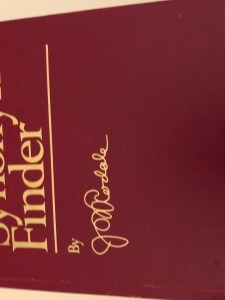 Finder (a book no writer can be without and a gift from my mom, who felt the same way) and begin to read.Strangely enough, winter wasn’t there. Happily, I found “Wintry.” It lead me to delicious choices like hibernal. Hiemal. Brumal. Cold. Frigid. Freezing. Ice-cold. Shiveringly cold. Icy. Frosty, snowy, arctic, glacial or hyperboreal. Then on to Siberian, inclement, stormy, blizzardly, windy, bitter, nippy, sharp, piercing, biting, cutting, brisk, severe, rigorous, hard, and cruel.
Finder (a book no writer can be without and a gift from my mom, who felt the same way) and begin to read.Strangely enough, winter wasn’t there. Happily, I found “Wintry.” It lead me to delicious choices like hibernal. Hiemal. Brumal. Cold. Frigid. Freezing. Ice-cold. Shiveringly cold. Icy. Frosty, snowy, arctic, glacial or hyperboreal. Then on to Siberian, inclement, stormy, blizzardly, windy, bitter, nippy, sharp, piercing, biting, cutting, brisk, severe, rigorous, hard, and cruel.
(A plea here for using actual books rather than looking on line. On line you may get your answer but you probably won’t get a page full of other delicious words that tempt you in other directions.) I just casually opened a page, landed on tumultuous, and was drawn in by disordered, confused, mixed-up, untidy, irregular, shifting, mercurial, rowdy, explosive, volcanic, and then tempestuous, rampageous, and pugnacious. Had to stop and repeat tempestuous, rampageous, and pugnacious a few times.
Does this make you want to pick up your pen? Are you a writer like me, who loves lists of words? Who thinks it would be fun to create a character who actually uses the word hyperboreal, rampageous or pugnacious? I am particularly fond of the word truculent.
 If I read on in my trust Rodale’s, the book offers me some lovely dark words for a crime writer, particularly one who is writing during the dark months in a cold New England landscape. Here are some tasty words to sample over your morning coffee: bleak, desolate, stark, cheerless, gloomy, dismal, dreary, depressing, unpromising, somber, melancholy. How about dark, gray, overcast, sullen, or lowering? These words pretty well fit the woods behind my house, which are shades of brown and gray and have been since the leaves fell.
If I read on in my trust Rodale’s, the book offers me some lovely dark words for a crime writer, particularly one who is writing during the dark months in a cold New England landscape. Here are some tasty words to sample over your morning coffee: bleak, desolate, stark, cheerless, gloomy, dismal, dreary, depressing, unpromising, somber, melancholy. How about dark, gray, overcast, sullen, or lowering? These words pretty well fit the woods behind my house, which are shades of brown and gray and have been since the leaves fell.
When I go looking for “hibernal,” it isn’t there, but “hibernate” pops up at me, the perfect thing to do during the months of December, January, and February (with perhaps the occasional peep out to attend a holiday party?). Hibernate leads to: lie dormant, lie idle, lie fallow, stagnate, vegetate, and estivate. Perhaps more fitting, for those of us who find these winter months perfect for sitting at our desks and listening to the voices in our heads, there are these: withdraw, retire, seclude oneself, go into hiding, lie snug, lie close, hide out, hole up, sit tight.
I am looking forward to being holed up, lying snug, and secluded. But I love the almost song-like rhythm of:
hide out
Hole up
Sit tight.
Which leads me, since playing in dictionaries and Thesauruses is part of a writer’s fun, to  the far more positive word: snug. Try these lovely words on for size: cozy, intimate, comfortable, easeful, restful, relaxing, quiet, peaceful, tranquil, serene, informal, casual, warm, friendly, inviting.
the far more positive word: snug. Try these lovely words on for size: cozy, intimate, comfortable, easeful, restful, relaxing, quiet, peaceful, tranquil, serene, informal, casual, warm, friendly, inviting.
I am reminded of the snug in an English bar. Snug also suggests secret, private, covert, secluded, well-hidden, screened off.
So while you are reading this, I am secluded, screened off, and well-hidden at my desk, a space which is cozy, warm, and inviting, if a bit overcrowded with papers. And once the screen is up and the manuscript is open, I shall turn my back on the hibernal, bleak, stark, cheerless landscape outside.
Hide out
Hole up
Sit tight.
And probably proceed to kill someone, or at least put them in serious jeopardy.
What are you doing on this dark and somber day?
p.s. Evidence of my long-time fascination with words are these three sheets of paper, found while cleaning out a drawer this morning. They were efforts to expand the boys’ vocabularies.
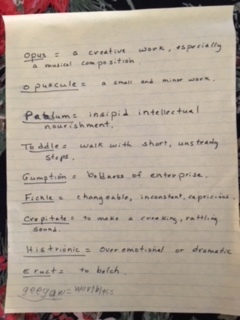
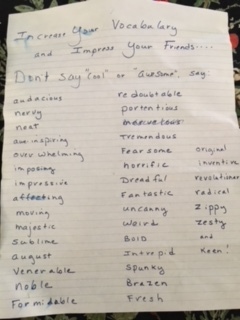
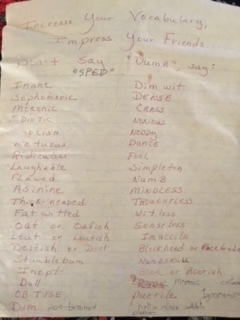
November 30, 2022
The Search for Rosanna C.
 Kaitlyn Dunnett/Kathy Lynn Emerson here, once again ecstatic to have solved a genealogical mystery. For a long time, two big questions about my family tree have gone unanswered. I was frustrated by my inability to find any source for the Irish DNA Ancestry.com kept insisting I have—between 5 and 8 % of the total. And I hadn’t been able to figure out how my German immigrant great-great-grandfather, who lived from the age of sixteen in a little town in rural New York State, could have met and married a “southern girl” from the state of Georgia. The answers, as it turned out, were in the same place—the 1850 census for Goshen, NY. Much like solving a murder, climbing a family tree involves following clues. Here’s how this investigation went.
Kaitlyn Dunnett/Kathy Lynn Emerson here, once again ecstatic to have solved a genealogical mystery. For a long time, two big questions about my family tree have gone unanswered. I was frustrated by my inability to find any source for the Irish DNA Ancestry.com kept insisting I have—between 5 and 8 % of the total. And I hadn’t been able to figure out how my German immigrant great-great-grandfather, who lived from the age of sixteen in a little town in rural New York State, could have met and married a “southern girl” from the state of Georgia. The answers, as it turned out, were in the same place—the 1850 census for Goshen, NY. Much like solving a murder, climbing a family tree involves following clues. Here’s how this investigation went.
My great-great-grandfather, William Coburg was born in about 1828 in Coburg, Germany. Family stories had him arriving in this country as one of two brothers, ages sixteen and fourteen. In the New York State census taken in 1855, he stated he was twenty-seven and had lived in Goshen, in Orange County, New York for eleven years, making his age sixteen and the date of his arrival 1844. In 1855, he had a wife, “Rosana Coberg,” age twenty-six, born in the state of Georgia and a resident of Goshen for nine years. They had two children, Mary, age two, and Henry, seven months.
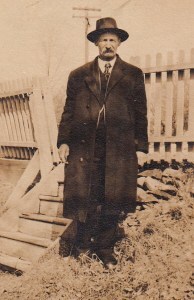
Henry Coburg, Rosanna’s son, the oldest family photo we have from this branch of the tree
Census takers were notoriously bad at spelling names and often got other details wrong, as well. Some people were skipped in the enumerations. Still, without the information they did collect, it would be a whole lot harder to find ancestors. In later census records, Rosanna is spelled Rossina, and in some she’s given the middle initial C. Her birth in Georgia is consistent, which goes along with the family story that William married “a southern girl.”
Assuming she had lived in Goshen for nine years, she should have been in the 1850 census. I already knew William did not show up in that one, but it didn’t occur to me until a few months ago to try a different approach. Using the search feature for that census, I typed in the first name Rosanna, no last name, a probable birth date of 1828, and Goshen as the location she lived in. She would have been around 21 in 1850. Her middle initial suggested her maiden name might begin with a C, and given the mystery in my DNA profile, the odds were also good that her family might be Irish.
A search for the name Rosanna in the 1850 census for Goshen turned up only two. One of them was a black woman. The other was Rosanna Conolly, age 22. Although this census states that she, her father (Constantine, 52), and her sister (Catherine, age 28) were all born in New York, in a later census Constantine’s birthplace is given as Ireland.

These details seem to suggest that this is the Rosanna who married William Coburg. Also suggestive is the fact that Rosanna’s nearest neighbor was a shoemaker, which was William Coburg’s profession. I had to wonder if it was possible that my ancestor was apprenticed to him, giving him the opportunity to meet and court the proverbial girl next door.
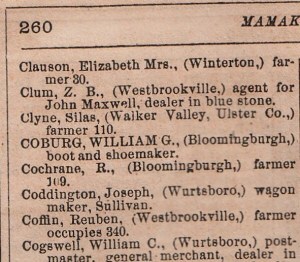
William’s ad from the 1872/3 Sullivan County Directory
Variations on the spelling of his nane made tracing Constantine a challenge, as does the existence of other men with the same name in both the U. S. and Ireland. Constantine turmed up as Constantine, Constine, and Constant. His surname was spelled Connolly, Connelly, Conolly, Connely, Connoley, Conley, Conoly, Conly, Canley, and even Gourley, The Goshen Constantine, whose age in 1850 indicates a birthdate of 1798, doesn’t seem to have any direct connection the state of Georgia, but there was a Constantine Connolly who lived in Georgia between the years 1823 and 1859, opening up the possibility that Rosanna might have been born on a visit to a relative in Savannah.
Documentation of the life of the Goshen Constantine begins on September 28, 1828, when the Presbyterian church in Goshen recorded his marriage to Rachael McLaughlin. Rachael’s death is also noted in the church’s records, occurring on September 20, 1835. Later census records reveal that Constantine was married twice. His first wife appears to have been the mother of both his daughters. Even though census records are not consistent about the year of Rosanna’s birth, the age given in her obituary, in February 1878, is fifty-one, placing her birth in 1827.
In searching for Constantine in other records, I found more evidence to suggest that Rosanna Coburg was his daughter. Constantine does not appear in the 1855 census, but in 1860, when he was also recorded as being deaf, he was living with Pat McLaughlin (b. Ireland 1810). Constantine’s age is given as 65 (b. Ireland 1795), and his occupation as laborer, but his relationship to McLaughlin is left blank. Given McLaughlin’s age, he could have been the brother of Constantine’s second wife. Even more likely is that he was Constantine’s son-in-law. Pat’s second wife, Catherine McLaughlin, was 36 in 1860, and therefore was born in about 1824—close enough, given census irregularities, to make it possible she was Rosanna’s older sister.
The final proof (as much proof as I ever expect to find) is in the census taken in 1870. Oddly enough, I already had this information. I just didn’t recognize its significance. By 1860, you see, William and Rosanna Coburg had moved to Wallkill, in nearby Ulster County, New York. Their family had continued to grow, adding another daughter, Frances. Then, in 1870, they were living in Bloomingburgh, in Sullivan County, about fifteen miles from Goshen, but, in Goshen, in the household headed by “Patrick McLauclin,” the census taker recorded three more names: Constantine Conley (75), May Coburgh (17), and Frances Coburgh (14). The presence of two of William and Rosanna’s daughters in residence on the day the census was taken makes perfect sense if they were there on a visit to their grandfather and their aunt.
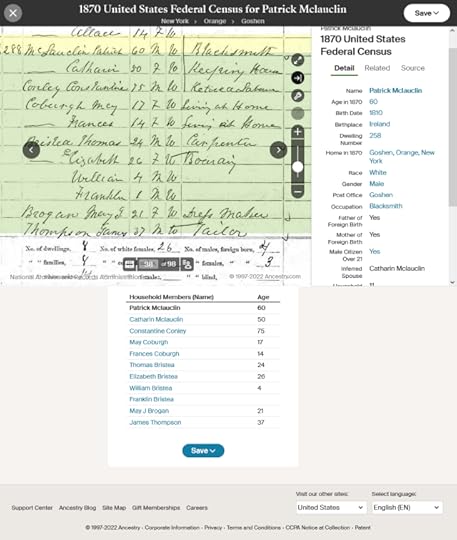
the final “proof” in the 1870 census
In 1875 the McLaughlins were still in Goshen and the Coburgs were still in Bloomingburgh, but Constantine no longer appears, suggesting that he died between 1870 and 1875.
Rosanna C. Coburg died on February 12, 1878 in Port Jervis, New York, where she had gone to visit her married daughter, Mary Kinner.

Kathy Lynn Emerson/Kaitlyn Dunnett has had sixty-four books traditionally published and has self published others, including several children’s books. She won the Agatha Award and was an Anthony and Macavity finalist for best mystery nonfiction of 2008 for How to Write Killer Historical Mysteries and was an Agatha Award finalist in 2015 in the best mystery short story category. She was the Malice Domestic Guest of Honor in 2014. Her most recent publications are The Valentine Veilleux Mysteries (a collection of three short stories and a novella, written as Kaitlyn) and I Kill People for a Living: A Collection of Essays by a Writer of Cozy Mysteries (written as Kathy). She maintains websites at www.KaitlynDunnett.com and www.KathyLynnEmerson.com.
November 28, 2022
Mystery novels avid readers recommend again and again
Charlene D’Avanzo: Several mystery novels avid readers (including me) repeatedly endorse:
 The Chief Inspector Gamache mysteries have gained dedicated fans over 17 novels (and counting). The first, Still Life, introduces Gamache who investigates murder in tiny Three Pines, Quebec where folks don’t lock their doors. Serene small town life is upset when a woman is found in the woods, an arrow in her heart. Locals call it a hunting accident, but the police inspector senses something is off. The story evolves as a classic whodunit but feels like anything but with deliberate pacing, dry wit, and lyrical writing. Reader note: These stories are best read in order.
The Chief Inspector Gamache mysteries have gained dedicated fans over 17 novels (and counting). The first, Still Life, introduces Gamache who investigates murder in tiny Three Pines, Quebec where folks don’t lock their doors. Serene small town life is upset when a woman is found in the woods, an arrow in her heart. Locals call it a hunting accident, but the police inspector senses something is off. The story evolves as a classic whodunit but feels like anything but with deliberate pacing, dry wit, and lyrical writing. Reader note: These stories are best read in order.
Agatha Christie is the queen of mystery and Murder on the Orient Express is one her most famous works, a genre classic. It was supposed to be the perfect crime. But an avalanche stops the Orient Express in its tracks just before a passenger is found murdered in his berth, foiling the perpetrator’s escape, and trapping 13 potential suspects – each with an airtight alibi – on the train with Inspector Hercule Poirot.
famous works, a genre classic. It was supposed to be the perfect crime. But an avalanche stops the Orient Express in its tracks just before a passenger is found murdered in his berth, foiling the perpetrator’s escape, and trapping 13 potential suspects – each with an airtight alibi – on the train with Inspector Hercule Poirot.
The bingeable mystery series by Jacqueline Winspear is a perfect balance of cozy and compelling, with darker details of WWI as backdrop and a wonderful heroine to root for. Book one introduces Maisie Dobbs who trades wartime nursing for her own private investigation practice at the Great War’s end. Her first case seems like a run-of-the-mill infidelity, but looking deeper Maisie finds disturbing secrets connected to the war, and she must confront her own trauma to solve the case. Maisie’s strong empathy and nurse’s training make her uniquely suited to detective work, and learning more about her is just as enjoyable as following the mystery.
 Gaudy Night, a Lord Peter Winsey-Harriet Vane mystery, is Dorothy Sayers’ tenth Lord Peter novel, the first told from the perspective of Harriet Vane’s perspective, and one of her finest. (They needn’t be read in order.) When Ms. Vane returns to Oxford for her college’s reunion (the title’s “gaudy”), a festive mood is threatened by an outbreak of murderous threats. Sayers makes this much more than a crime novel, though it’s a good one—through Harriet who struggles with questions of love and friendship, life and work, gender and class, and the writing life. Read this and then go back and read all the Lord Peter mysteries, beginning with Whose Body?.
Gaudy Night, a Lord Peter Winsey-Harriet Vane mystery, is Dorothy Sayers’ tenth Lord Peter novel, the first told from the perspective of Harriet Vane’s perspective, and one of her finest. (They needn’t be read in order.) When Ms. Vane returns to Oxford for her college’s reunion (the title’s “gaudy”), a festive mood is threatened by an outbreak of murderous threats. Sayers makes this much more than a crime novel, though it’s a good one—through Harriet who struggles with questions of love and friendship, life and work, gender and class, and the writing life. Read this and then go back and read all the Lord Peter mysteries, beginning with Whose Body?.
Sue Grafton is best known for her Kinsey Millhone Alphabet Mysteries. In A is for alibi Kinsey sets up a new detective agency in Santa Teresa, California. She’s a classic noir detective—twice-divorced, a loner, fond of the underdog—and she finds herself drawn in by a woman out on parole for her husband’s murder. As twists keep coming (and the bodies stack up), Kinsey is more and more danger. Kinsey is a great character: rough around the edges, tough and motivated.
I’ll end with a book sitting on my bedside table: Death at La Fenice by Donna Leon whose books are called “the next best thing to being in Venice.” Here, a world-renowned conductor’s intermission refreshment comes one night with a little something extra – cyanide. Guido Brunetti, vice-commissario of police and detective genius, finding a suspect isn’t a problem but narrowing the large group of enemies down to one is. As Brunetti pieces together clues, a shocking picture of depravity and revenge emerges, leaving him torn between what is and what should be right — and questioning what the law can do, and what needs to be done.
books are called “the next best thing to being in Venice.” Here, a world-renowned conductor’s intermission refreshment comes one night with a little something extra – cyanide. Guido Brunetti, vice-commissario of police and detective genius, finding a suspect isn’t a problem but narrowing the large group of enemies down to one is. As Brunetti pieces together clues, a shocking picture of depravity and revenge emerges, leaving him torn between what is and what should be right — and questioning what the law can do, and what needs to be done.
November 25, 2022
Weekend Update: November 26-27, 2022
 Next week at Maine Crime Writers there will be posts by Charlene D’Avanzo (Monday), Kaitlyn Dunnett/Kathy Lynn Emerson (Thursday), and Kate Flora (Friday).
Next week at Maine Crime Writers there will be posts by Charlene D’Avanzo (Monday), Kaitlyn Dunnett/Kathy Lynn Emerson (Thursday), and Kate Flora (Friday).
In the news department, here’s what’s happening with some of us who blog regularly at Maine Crime Writers:
An invitation to readers of this blog: Do you have news relating to Maine, Crime, or Writing? We’d love to hear from you. Just comment below to share.
And a reminder: If your library, school, or organization is looking for a speaker, we are often available to talk about the writing process, research, where we get our ideas, and other mysteries of the business, along with the very popular “Making a Mystery” with audience participation, and “Casting Call: How We Staff Our Mysteries.” We also do programs on Zoom. Contact Kate Flora
November 24, 2022
November 23, 2022
Unexplained Aerial Phenomena (UAPs) by Matt Cost
On Aug. 4, 2020, Deputy Secretary of Defense David L. Norquist approved the establishment of an Unidentified Aerial Phenomena (UAP) Task Force.
That’s right. UAPs are the new UFOs.
On June 25th, 2021, the task force presented a preliminary report that there is definitely something going on in the skies, but they have no idea what it is.
The Pentagon confirmed the authenticity of pictures and videos gathered by the Task Force, purportedly showing “what appears to be pyramid-shaped objects” hovering above the USS Russell in 2019, off the coast of California, with spokeswoman Susan Gough saying “I can confirm that the referenced photos and videos were taken by Navy personnel. The UAPTF has included these incidents in their ongoing examinations.”
I believe that the government is trying to obfuscate what is happening above our heads so as to not create alarm. The task force has gone through various increasingly confusing name changes over the past two years and have had little luck in getting to the bottom of hundreds of sightings.
The phenomena of UFOs began during WWII when pilots began to see unexplained oddities in the sky that they called ‘foo fighters’.
This was followed by the Roswell incident of 1947 in which debris was found at a ranch in New Mexico. The government claimed it was the debris of a weather balloon. People did not believe them. Some conspiracists believe the wreckage was spirited to a hush-hush military site in southern Nevada called Area 51, where study of the aliens and their craft continues to this day.

From 1952-1969, the US government investigated 12,600 mysterious sighting through a program called Project Blue Book. This investigative committee was disbanded and there was no official program looking into UFOs or UAPs for almost fifty years.
On November 14, 2004, a UAP was recorded about 100 miles southwest of San Diego, CA. The USS Nimitz Carrier Strike Group, including the missile cruiser USS Princeton, were performing drills. Among the group were two F/A-18F Super Hornet fighter pilots. During the training, they were suddenly asked to proceed to new coordinates for a possible real-life situation. Before this, a radar operator in the group had been picking up anomalous aerial vehicles (AAVs) — the Navy’s term for UAPs — for several days at an altitude of over 80,000 feet.

However, after detecting AAVs at lower altitudes, the two pilots were sent to intercept the objects. At first, the pilots couldn’t see the AAVs, but they did notice a disturbance in the water. Suddenly, a Tic Tac-shaped aircraft appeared, moving quickly and erratically before speeding off. While the encounter wasn’t captured on video, a different pilot was able to record the aircraft leaving. This report was buried for almost twenty years, until the implementation of the Unexplained Aerial Phenomena Task Force in 2020.
This and 143 incidents have so-far been unexplainable by the UAP task force. They have recently listed five purposes of the program. Number four is to mitigate and defend US airspace. Possible explanations include foreign aircraft (Russia, China), secret US programs, or aliens.

It would seem that UFOs or UAPs are real and fascinating. And now, for the shameless plug. This is also the basis for the December 21st publication of my fourth Clay Wolfe/Port Essex mystery, Cosmic Trap. Clay, Baylee, and gang are tasked with being the local liaison for two UAP Task Force members investigating multiple sightings in the skies of Port Essex.
About the Author
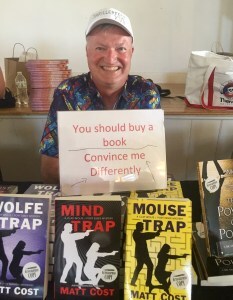 Matt Cost was a history major at Trinity College. He owned a mystery bookstore, a video store, and a gym, before serving a ten-year sentence as a junior high school teacher. In 2014 he was released and began writing. And that’s what he does. He writes histories and mysteries.
Matt Cost was a history major at Trinity College. He owned a mystery bookstore, a video store, and a gym, before serving a ten-year sentence as a junior high school teacher. In 2014 he was released and began writing. And that’s what he does. He writes histories and mysteries.
Cost has published four books in the Mainely Mystery series, with the fifth, Mainely Wicked, due out in August of 2023. He has also published three books in the Clay Wolfe/Port Essex series, with the fourth, Cosmic Trap, due out in December of 2022.
For historical novels, Cost has published At Every Hazard and its sequel, Love in a Time of Hate, as well as I am Cuba. In April of 2023, Cost will combine his love of histories and mysteries into a historical PI mystery set in 1923 Brooklyn, Velma Gone Awry.
Cost now lives in Brunswick, Maine, with his wife, Harper. There are four grown children: Brittany, Pearson, Miranda, and Ryan. A chocolate Lab and a basset hound round out the mix. He now spends his days at the computer, writing.
Lea Wait's Blog
- Lea Wait's profile
- 509 followers




